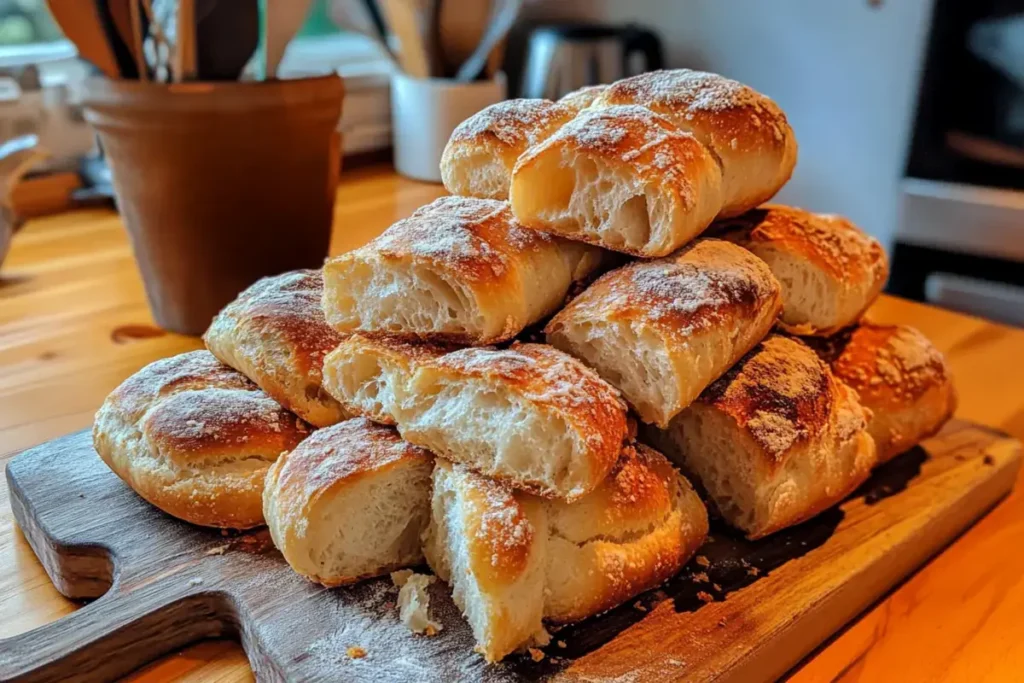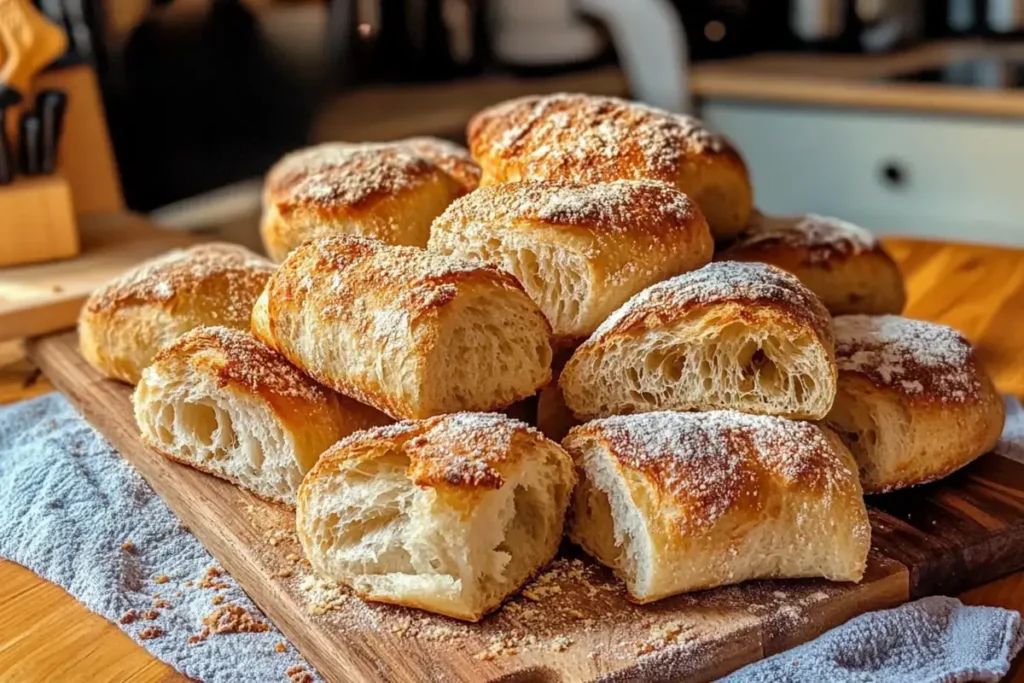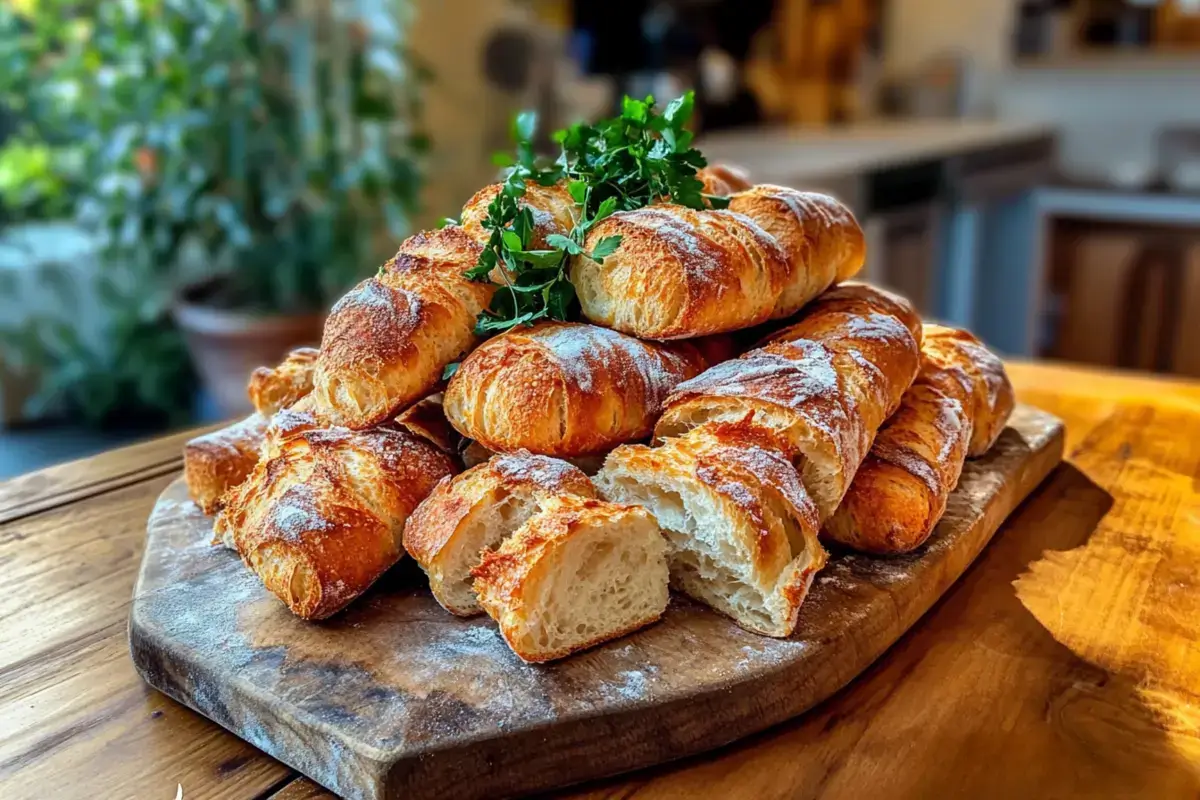What are ciabatta rolls good for? They are a delightful Italian bread option with a firm crust and airy interior. These popular rolls work in various recipes, from sandwiches to gourmet appetizers. Furthermore, they bring rustic charm and a pleasing chew to any meal. Below, we will explore their history, versatility, health aspects, and creative uses. Get ready for an in-depth look at the world of ciabatta rolls and discover how they can elevate your culinary adventures.
Discovering What Are Ciabatta Rolls Good For?
Ciabatta rolls originated in Italy as a response to the French baguette. The creator aimed to develop a bread that could rival the baguette’s popularity while retaining a distinctly Italian identity. The result is a roll with a porous crumb, chewy texture, and a crusty exterior. These rolls work beautifully for sandwiches, bruschetta, and more.
Some people appreciate ciabatta rolls for their robust flavor. Others enjoy how easily they can soak up delicious sauces and spreads. Whether you’re planning a light lunch or a hearty dinner, ciabatta rolls fit right in. As you learn what are ciabatta rolls good for, you’ll see they’re more than just bread—they’re a versatile canvas for creative cuisine.
The Italian Heritage:
Ciabatta means “slipper” in Italian, reflecting the bread’s flat, elongated shape. While ciabatta bread originated in Veneto, variations are found throughout Italy. Each region adds a unique twist to the dough, influencing flavor, texture, and appearance.
Despite regional nuances, ciabatta rolls maintain a consistent hallmark: large holes in the crumb. This holey structure forms when high-hydration dough ferments. The chewy consistency pairs well with olive oil, cured meats, and cheeses. From classic bruschetta to panini, the bread’s design caters to modern tastes while respecting centuries-old traditions.
Key Ingredients and Baking Process:
Ciabatta rolls typically contain just a few essential ingredients:
- Flour (often a combination of wheat flour types)
- Water
- Yeast
- Salt
Some bakers include olive oil or a starter (biga) for extra flavor. The dough remains wet, requiring gentle shaping to preserve air bubbles. This high-hydration dough ferments slowly, which allows for maximum flavor development.
When baked at high temperatures, ciabatta rolls develop a signature crispy crust. Inside, the crumb stays moist and springy, ready to soak up oils, dressings, or dips. Additionally, you can bake these rolls in various shapes—round, square, or rectangular—to suit different dishes.
The Unique Texture:
One reason ciabatta rolls stand out is their airy, holey interior. This texture emerges from high water content and gentle handling. Unlike dense breads, ciabatta’s large pockets allow flavors to mingle within the bread. For instance, a drizzle of balsamic vinegar or a slice of tomato can seep into the crumb, imparting a fresh taste with every bite.
Moreover, the crusty exterior adds another dimension to the eating experience. It brings a welcome crunch that contrasts the soft interior. Whether you choose a simple butter topping or more elaborate fillings, these textural differences enhance every mouthful.

Why Ciabatta Rolls Shine in Various Meals?
At this point, you may ask again: “What are ciabatta rolls good for?” They adapt seamlessly to multiple culinary scenarios. In this section, we’ll dive into how they fit different meals, from breakfast spreads to evening feasts.
Morning Options :
Ciabatta rolls can elevate your breakfast routine. Sliced in half, they toast nicely, delivering a warm, crispy base. Add scrambled eggs, bacon, and a sprinkle of cheese for a hearty morning sandwich. Alternatively, spread avocado or ricotta cheese for a lighter option.
Their airy crumb also absorbs flavors effectively. Consider dipping them in olive oil infused with herbs, pairing them with fruit preserves, or topping them with fresh tomatoes. The roll’s texture and subtle tang create a perfect balance, making mornings more enjoyable.
Lunch Favorites :
Lunchtime is prime territory for ciabatta rolls. Their sturdy crust holds up to an array of fillings:
- Sliced turkey or roasted vegetables
- Fresh mozzarella with basil
- Tuna salad with crunchy lettuce
Because ciabatta can hold wet ingredients without getting soggy, it’s perfect for sandwiches that might otherwise make bread too soft. You can even press your sandwich into a panini for extra crispiness. The toasty finish complements the bread’s natural flavors, turning any midday meal into a standout.
Dinner Delights :
Ciabatta rolls aren’t limited to sandwiches. They work well as a side dish, too. Serve them alongside pasta, stew, or soup. Their porous interior soaks up savory sauces. You can also brush them with olive oil and top with roasted garlic for a gourmet dinner roll.
If you’re entertaining guests, consider a tray of mini ciabatta sliders. Fill them with pulled pork, grilled chicken, or marinated tofu. The contrasting textures of crunchy crust and tender filling create a memorable bite. Whether you opt for a formal setting or a casual get-together, ciabatta rolls enhance the overall dining experience.
Appetizers and Party Bites :
Wondering “What are ciabatta rolls good for” in terms of party snacks? They can be sliced thin to create crostini. Add bruschetta toppings, tapenade, or a dab of herbed cheese. The crunchy base welcomes creative garnishes, while the roll’s mild flavor keeps the focus on your chosen toppings.
For an elegant starter, top thin slices with smoked salmon or prosciutto, a dollop of cream cheese, and fresh herbs. The airy crumb ensures each bite remains light yet satisfying. This approach brings a touch of sophistication to any gathering.
Nutritional Overview and Health Considerations
No discussion of what are ciabatta rolls good for would be complete without addressing health aspects. While they may not be the most low-carb choice, they do offer certain benefits. Let’s explore their nutritional profile, common health concerns, and ways to incorporate them into a balanced lifestyle.
Basic Nutrition :
Ciabatta rolls primarily contain carbs from refined wheat flour. They also have a moderate protein content, especially if the recipe includes certain flour blends. Because of their unique texture and large air pockets, they’re often less dense than other breads.
However, ciabatta rolls can still be caloric if you eat multiple servings or load them with heavy spreads. Paying attention to portion sizes helps maintain balance. Pairing ciabatta with nutrient-dense fillings like vegetables, lean proteins, and healthy fats can boost the overall nutritional value of your meal.
Possible Concerns :
People with gluten sensitivities or celiac disease must avoid standard ciabatta rolls. While some gluten-free variations exist, the classic recipe relies heavily on wheat flour. Additionally, the refined flour in ciabatta might not provide the same fiber and nutrient profile as whole-grain breads.
That said, you can occasionally enjoy ciabatta rolls as part of a balanced diet. Moderation, along with healthful companions like salads or soups, helps mitigate any negative impacts. Always listen to your body and consult a healthcare professional if you have specific dietary restrictions.
Healthier Tweaks :
If you love ciabatta rolls but crave more nutrition, consider making or finding whole-wheat ciabatta. This variant uses a portion of whole-grain flour, adding fiber and micronutrients. You can also top your ciabatta with nutrient-rich options such as:
- Spinach or arugula
- Avocado slices
- Grilled vegetables
- Lean proteins like turkey or chicken breast
Choosing lower-sodium ingredients and limiting high-fat spreads also helps keep your meal balanced. By combining ciabatta rolls with wholesome fillings, you maintain flavor while fueling your body effectively.

Creative Ways to Enjoy Ciabatta Rolls
Many people wonder, “What are ciabatta rolls good for beyond standard sandwiches?” In truth, these rolls can feature in creative culinary ideas. They’re not just for savory dishes. You can also explore sweet or fusion-style recipes. Let’s delve into some imaginative ways to maximize their versatility.
Gourmet Toast Ideas :
Toast slices of ciabatta and experiment with flavorful toppings:
- Fig and Goat Cheese: Spread soft goat cheese, add fresh fig slices, and drizzle honey.
- Roasted Veggies and Ricotta: Layer roasted eggplant, zucchini, and peppers over ricotta cheese.
- Caramelized Onion and Brie: Slow-cook onions until golden, top with brie, and finish with a dash of balsamic glaze.
Each bite provides a harmony of textures, and the bread’s airy structure enhances each ingredient’s taste.
Dessert-Inspired Creations :
Although ciabatta rolls are known for savory applications, they can step into dessert territory, too:
- Chocolate Hazelnut Spread: Toast slices, then coat them with chocolate hazelnut spread. Top with sliced strawberries or banana.
- Sweet French Toast: Soak slices in a mixture of eggs, milk, cinnamon, and a pinch of sugar. Pan-fry until golden. The crust’s crunch merges beautifully with the custardy interior.
These sweet twists showcase ciabatta’s adaptability and offer a fun departure from typical bread-based desserts.
Bold Flavor Infusions :
Want to get adventurous? Infuse your ciabatta rolls with garlic, herbs, or cheese during baking. By mixing minced herbs like rosemary into the dough, you create a fragrant roll that needs minimal extra seasoning. Alternatively, swirl some shredded cheese into the dough for a subtle savory note. Each infused loaf carries distinct aromas and tastes.
If you’d rather not modify the dough itself, brush the crust with flavored oils before baking. For instance, rosemary olive oil or chili-infused oil adds a new dimension. This technique heightens flavor without needing an elaborate recipe.
Accompaniments to Soup and Stew :
Picture a chilly evening with a hearty bowl of soup or stew in front of you. A ciabatta roll completes the scene, allowing you to dunk and scoop. The bread’s crisp exterior holds firm, while the sponge-like interior soaks up all the rich broth or sauce.
For lighter soups, like vegetable or tomato bisque, ciabatta offers that much-needed texture contrast. The synergy between the bread’s crunch and the soup’s smoothness makes each spoonful more gratifying. Keep an extra roll on hand if you love to dip!
Elevating Everyday Meals with Ciabatta
By now, you may notice a recurring theme in the question, “What are ciabatta rolls good for?” They can transform everyday meals into something extraordinary. Below, we’ll look at how you can make the most of these rolls in simple, impactful ways.
Meal Prep and Make-Ahead Options :
Ciabatta rolls can be a lifesaver if you need quick, homemade meals. Bake or purchase a batch and store them in the freezer. Then, pull out the rolls when needed. Whether you have leftover chicken or fresh mozzarella, a quick ciabatta sandwich comes together in minutes.
For added convenience, prepare sandwich fillings in advance. Keep roasted vegetables, grilled proteins, or spreads in the fridge. Then, assemble your meal whenever hunger strikes. This approach helps you maintain a balanced diet without resorting to fast food.
Hosting a DIY Sandwich Bar :
Planning a family gathering or informal party? Set up a DIY sandwich bar featuring ciabatta rolls. Lay out different meats, cheeses, vegetables, and condiments. Everyone can craft a unique sandwich. This interactive approach encourages creativity and caters to diverse preferences. Plus, it’s low-stress for the host. Ciabatta rolls hold up under a variety of fillings, so each guest’s creation remains intact and delicious.
Building Bruschetta Trays :
If you’ve ever dined in Italy or visited an Italian restaurant, you’ve likely seen bruschetta made with sliced, toasted bread. Ciabatta’s structure and flavor make it a prime candidate for bruschetta trays. Classic tomato-basil toppings shine on this bread. However, you can also experiment with:
- Artichoke hearts and shaved Parmesan
- Fig jam and prosciutto
- White bean puree and roasted red peppers
Arranging several bruschetta options on a platter creates a vibrant centerpiece for any celebration. The crispy edges and soft middle accentuate each topping’s flavor and texture, turning your tray into a feast for the senses.
Creating Rustic Pizza or Flatbread :
If you’re searching for another creative way to use ciabatta, consider rustic pizzas. Slice the rolls horizontally and lay them flat on a baking sheet. Spread tomato sauce, scatter mozzarella, and add your favorite toppings—think olives, mushrooms, or spicy pepperoni. Bake until the cheese melts and the edges crisp.
This method is simpler than making pizza dough from scratch, yet it still yields excellent results. The bread’s crusty nature mimics traditional pizza crust. It’s a fun project for children or anyone wanting to enjoy homemade pizza without the extra steps.

FAQs
What do you eat ciabatta bread with?
You can pair ciabatta bread with almost anything: olive oil and balsamic vinegar, soups, salads, or pasta. It’s also perfect for sandwiches stuffed with meats, vegetables, or cheeses. The porous interior absorbs spreads and dressings, enhancing every bite.
What is ciabatta used for?
Ciabatta is commonly used in sandwiches, bruschetta, and even as a side for soups or stews. Its airy crumb and sturdy crust make it ideal for holding fillings and soaking up flavorful sauces. Many also enjoy it toasted with garlic and olive oil for a simple appetizer.
Is a ciabatta roll healthy?
A ciabatta roll can be part of a healthy diet when consumed in moderation and paired with nutrient-dense fillings. It mostly contains refined flour, which has fewer nutrients than whole-grain alternatives. However, combining it with vegetables, lean proteins, and healthy fats can make for a balanced meal.
Is ciabatta healthier than bread?
Ciabatta is a type of bread, so its health benefits depend largely on the specific ingredients used. Classic ciabatta often uses refined flour and can have a higher carbohydrate content. If you opt for whole-wheat versions and wholesome toppings, it can be as healthy as other quality bread options.

